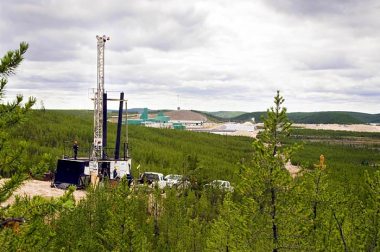Long-term production schedules for the McArthur River uranium operation in Canada have been modified to incorporate additional mineral reserves detailed in a newly updated technical report released by Cameco.
 |
| Drilling at McArthur River (Image: Cameco) |
The revised estimates see the conversion of mineral resources to reserves, with an increase in total proven and probable reserves to 385.5 million pounds U3O8 (148,282 tU), up from 324 million pounds U3O8 (124,626 tU) at the end of 2011. Total measured and indicated resources for the Northern Saskatchewan project now stand at 11.8 million pounds U3O8 (4539 tU), with inferred resources of 56.3 million pounds U3O8 (21,666 tU), down from 73.1 and 86.4 million pounds U3O8 (28,118 and 33,234 tU), respectively. All figures are compliant with Canadian National Instrument 43-101 (NI 43-101), an internationally used standard for classifying uranium resources.
The change in reserve estimates are primarily due to the addition of probable reserves from an area known as Zone B and the incorporation and upgrading of mineral resources from another area, McA South.
In response to the additional reserves, the production schedule has been modified to include a production rate increase to 22.0 million pounds U3O8 (8462 tU) per year from 2018, with average production forecast to be 21.5 million pounds per year (8270 tU) from 2018 to 2026, before production begins to decrease towards the end of mine life in 2034. Licensed production capacity is currently 18.7 million pounds U3O8 (7193 tU) per year. Approval will be required from the Canadian Nuclear Safety Commission for the production rate increase, although Cameco CEO Tim Gitzel said in the company's quarterly results conference call that he did not foresee any problems with securing regulatory approval.
McArthur River is the world's largest known high-grade uranium deposit, with average ore grades of 16.89% U3O8. It is owned by the McArthur River Joint Venture, of which Cameco owns 69.8% and Areva Resources Canada own 30.2%. Some 225 million pounds U3O8 (over 86,500 tU) have been produced from the existing underground mine since operations began in 1999.
Cameco estimates its total share of capital costs over the total mine life for the combined McArthur River and the Key Lake mill, where McArthur River's uranium is processed, will now be some $2.5 billion, up from the $1.4 billion estimated in the previous technical report from 2009. Over 40% of that is related to the additional forecast production, with 15% related to expenditures necessary to support the higher production rate and the rest related to infrastructure to support the ongoing operations and general cost escalation. Operating costs are estimated to average $19.23 per pound U3O8. Although this is only slightly lower than the estimated costs in the 2009 figures, the decrease is considered to be significant in the light of a general trend of escalating costs across the mining industry, Cameco notes.
The technical report was released days after Cameco announced cuts to its overall production forecast to 2018 in response to ongoing market uncertainties. However, the company stressed that it remained confident in the long-term fundamentals of the uranium industry.
Researched and written
by World Nuclear News






_53514_33880.jpg)






